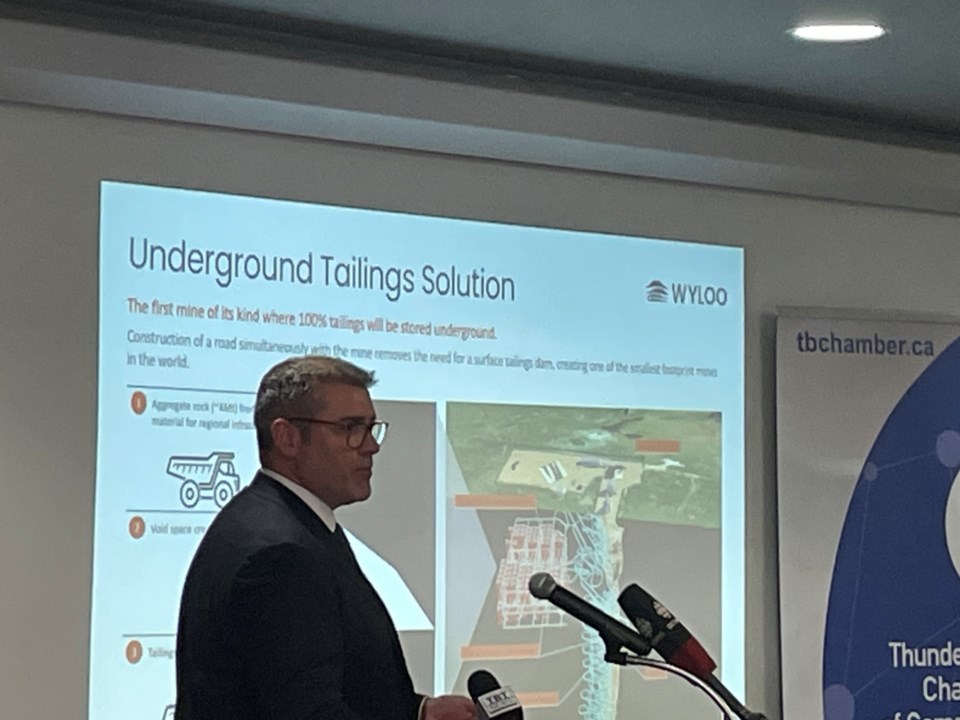THUNDER BAY — Kristan Straub provided an update on the proposed Eagle’s Nest mining project on Jan. 23 in Thunder Bay.
The chief executive officer of Wyloo Canada delivered a presentation describing how far the project has come.
One concern about the Eagle’s Nest project is the fact that it is being built on treaty-protected lands, meaning any development in the region needs to happen in consultation with and approval from surrounding First Nations communities.
The Ring of Fire is a minerally-enriched area of wetlands in the James Bay region, about 500 kilometres northwest of Thunder Bay.
The area is home to around nine First Nations communities. The project is positioned to provide employment for residents of local First Nations.
Straub mentioned discussions about training and employment opportunities with Matawa First Nations and Kiikenomaga Kikenjigewen Employment and Training Services (KKETS).
“There are training structures that are already established. We would either look to leverage those training structures or if there was a need to create something that was individual and reflected the resources and the skills that we require then we would of course invest in that to be able to build a training centre,” he said.
So far, Webequie First Nation and Marten Falls First Nation have both signed memorandums of understanding with Wyloo.
Straub said that Wyloo is working to garner more support by keeping dialogue active and open with Indigenous communities.
“We have and continue to reach out to other First Nations within the region offering to have a discussion about how they could partner with us and with Webequie and Marten Falls in future developments,” Straub said.
“It’s not going to be a process where we just push forward without the participation and the support of other First Nations, but it’s founded on the support and the principle of having partnerships and cooperation with Webequie, with Marten Falls, and with others as they come along.”
When pressed about how Wyloo might proceed (or not) with the Eagle’s Nest project in the event that some First Nations in the area - such as Neskantaga First Nation - do not approve, Straub maintained his stance.
“I think ‘nearby First Nations’ depends on what you consider ‘nearby.’
“Webequie and Marten Falls are definitely the two closest First Nations in a nearby framework and those are the two that we continue to work with. The First Nations that are in the region around we will look to build support in collaboration with them. Ultimately, that’s their decision whether they partner-in or not.”
It was at the end of September that the Land Defence Alliance, consisting of four Chiefs from First Nations in the Ring of Fire region, demanded a meeting with Premier Doug Ford to prevent further mining development projects around their communities and on their lands without active First Nations involvement and control.
Ford did not attend the meeting at Queen’s Park.
Straub, on the other hand, made it clear that Wyloo intends to remain at the table.
He also said the project is aiming high when it comes to environmental impacts.
In his presentation, Straub highlighted how Eagle’s Nest has been designed to minimize its ecological footprint - with few buildings on the surface and an underground tailings dam.
He explained why an underground tailings dam gives the mine an environmental edge.
“What we have seen through past performance in these environments is that there isn’t any impact to surrounding rock - the surrounding rock is not fractured, it doesn’t conduct water through it, you don’t see any transmission of materials outside of that.
“And that’s the large concern when it comes to elements that are related to tailing storage facilities - particularly at the surface,” he said.
Next steps for the Eagle’s Nest project include conducting an internal feasibility study to determine whether the proposed nickel mine will bear the volume of nickel that Wyloo estimates it should and developing a partnership agreement with local First Nations.
The federal government is also set to conduct a regional assessment of the Ring of Fire to determine the potential impact of mining operations in the area.
Straub said Wyloo is still waiting to see the terms of reference for the regional assessment. He described how the Eagle’s Nest project is leading the pack compared to other developments in the region.
“One of the interesting things about cumulative effects is ‘what happens after the second project is developed?’” he said.
“So, being the first project under the regional assessment, we believe that our impacts would be captured under that and we would have a good understanding of it. Of course, we’ll make recommendations on future actions that must be taken.
“We will work with the federal government on understanding what those recommendations are, how they would be incorporated into our operating procedures and our operating plan.”
The project aims to break ground in 2027.
